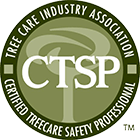The Atlantic hurricane season is a time when most tropical cyclones are expected to develop across the northern Atlantic Ocean. It is currently defined as the time frame from June 1 through November 30. What plans should prudent home owners take with the trees in their landscape?

Hurricanes and Violent Storms
“It is important that people who live in the East and Gulf coastal areas be prepared,” says Tchukki Andersen, Board Certified Master Arborist, Certified Tree Safety Professional and staff arborist for the Tree Care Industry Association. “Even people in the Midwestern states should heed the warning. Right now, get your trees as ready as they can be to survive a major storm. Don’t wait until the storm is headed your way.”
One of the greatest dangers to life and property during hurricanes is posed by falling trees and limbs. “Larger trees in leaf will ‘catch’ more wind and be subjected to increased mechanical stresses. These stresses increase the chances of either branch or whole-tree failure,” explains Andersen. “Preparing trees for a high-wind event should be done well in advance of the storm season. However, it’s not too late to start preparing, now. To help ease these dangers, have a qualified tree care provider evaluate your trees. Doing this will help determine potential weaknesses and dangers.”
Look at your trees for the following warning signs:
- Wires in contact with tree branches. Trees may become energized when they are contacted by electric wires.
- Dead or partially attached limbs hung up in the higher branches that could fall and cause damage or injury.
- Cracked stems and branch unions that could cause catastrophic failure of a tree section.
- Hollow or decayed areas on the trunk or main limbs, or mushrooms growing from the bark that may indicate a decayed and weakened stem.
- Peeling bark or gaping wounds in the trunk could also indicate structural weakness.
- Fallen or uprooted trees putting pressure on other trees beneath them.
- Tight, V-shaped branch unions, which are much more prone to failure than open, U-shaped unions.
- Heaving soil at the tree base is a potential indicator of an unsound root system.
A tree is a living, growing, changing thing, and its integrity and stability could change over time. Don’t assume that a tree that has survived nine severe storms will necessarily survive a tenth. Simultaneously, not all large trees are dangerous.
FIND A PROFESSIONAL
A professional arborist can assess your landscape and work with you to determine how to best prepare your trees for storm season. CS Tree Services has three board certified TCIA arborists on staff who can give you expert advice on storm prep. Our full service, fully insured crew can perform any tree services you require. Call us for your free consultation at 919-355-8299 or visit us at CSTreeServices.com.
Editorial Credit: www.treecaretips.org






